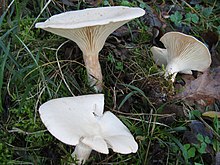Infundibulicybe
| Infundibulicybe | |
|---|---|

| |
| Infundibulicybe geotropa | |
| Scientific classification | |
| Domain: | Eukaryota |
| Kingdom: | Fungi |
| Division: | Basidiomycota |
| Class: | Agaricomycetes |
| Order: | Agaricales |
| Family: | incertae sedis |
| Genus: | Infundibulicybe Harmaja (2003) |
| Type species | |
| Infundibulicybe gibba (Pers.) Harmaja (2003) | |
| Species | |
|
20, see text | |
Infundibulicybe is a genus of fungi that is robustly placed incertae sedis as sister group to the Tricholomatoid clade.[1][2] It has previously been part of the family of Tricholomataceae, but recent molecular phylogeny has shown it to take an isolated position within the Agaricales.[1]
Description
The fruitingbody of Infundibulicybe is clitocyboid and not hygrophanous. The cap diameter can vary from 1,5 to 25 cm, with some growing as large as 40 cm. Its shape can be depressed to funnel-like with a velvety to finely scaly surface. The colouration of the basidiocarp is white to pale buff to buff, pinkish buff, yellowish, yellowish brown, orange brown, reddish brown or greyish brown. The gills are decurrent to deeply decurrent. This basidiomycete smells faint, from cyanic to sweet aromatic and faintly camphor-like when fresh. The spore deposit is whitish and spores are dikaryoid, smooth, hyaline and without iodine reactions. The basidia are 4-spored, cheilocystidia are absent and clamp connections present. They grow saprotrophic on litter of leaves and needles or soil in forests, grassland and alpine habitats.[3][4]
Infundibulicybe shares some characteristics with Omphalina, like the cream-reddish brown tinges of pileus and stipe, the deeply decurrent lamellae and strongly encrusting pigment.[4][5] Another member of the group, I. lateritia is a rare alpine-arctic species strictly associated with Dryas octopetala (Rosaceae).[6]
Taxonomy
| |||||||||||||||
| Agaricales Phylogeny[1] |
The group was formerly included in the genus Clitocybe, but in 2003 was erected to genus level to accommodate species for which mycelium cannot reduce nitrate and basidiospores do not adhere in tetrads, but exhibit a lacrymoid (tear-shaped) morphology, a confluent base and a cyanophobic basidiospore wall.[4] The genus contains 19 widespread species according to the Index Fungorum and one new species I. rufa, only known from high altitude localities in southwestern China, described in 2016.[7][8]
The type species of the genus, as defined by the author Harmaja, is I. gibba.[4]
Species
- I. alkaliviolascens
- I. altaica[4]
- I. bresadolana[4]
- I. catinus[4]
- I. costata[4]
- I. dryadum[4]
- I. geotropa[4]
- I. gibba[4]
- I. gigas[4]
- I. glareosa[4]
- I. lapponica[4]
- I. lateritia[6]
- I. mediterranea[5]
- I. meridionalis
- I. montana[4]
- I. rufa[8]
- I. sinopicoides[4]
- I. splendoides
- I. squamulosa[4]
- I. trulliformis
See also
References
- ^ a b c Matheny PB, Curtis JM, Hofstetter V, Aime MC, Moncalvo JM, Ge ZW, Slot JC, Ammirati JF, Baroni TJ, Bougher NL, Hughes KW, Lodge DJ, Kerrigan RW, Seidl MT, Aanen DK, DeNitis M, Daniele GM, Desjardin DE, Kropp BR, Norvell LL, Parker A, Vellinga EC, Vilgalys R, Hibbett DS (2006). "Major clades of Agaricales: A multilocus phylogenetic overview". Mycologia. 98 (6): 982–995. doi:10.3852/mycologia.98.6.982. PMID 17486974.[permanent dead link]
- ^ Binder M, Larsson KH, Matheny PB, Hibbett DS (2010). "Amylocorticiales ord. nov. and Jaapiales ord. nov.: Early diverging clades of Agaricomycetidae dominated by corticioid forms". Mycologia. 102 (4): 865–880. doi:10.3852/09-288. PMID 20648753. S2CID 23931256.
- ^ Knudsen H, Vesterholt J (2012). Funga Nordica: Agaricoid, boletoid, clavarioid, cyphelloid and gastroid genera (2nd ed.). Copenhagen: Nordsvamp. p. 1082. ISBN 978-87-983961-3-0.
- ^ a b c d e f g h i j k l m n o p q Harmaja H (2003). "Notes on Clitocybe s. lato (Agaricales)". Annales Botanici Fennici. 40 (1): 213–218.
- ^ a b Vizzini A, Contu M, Musumeci E, Ercole E (2011). "A new taxon in the Infundibulicybe gibba complex (Basidiomycota, Agaricales, Tricholomataceae) from Sardinia (Italy)". Mycologia. 103 (1): 203–208. doi:10.3852/10-137. hdl:2318/76272. PMID 20943527. S2CID 2046773.
- ^ a b Vizzini A, Curti M, Contu M, Ercole E (2012). "A new cystidiate variety of Omphalina pyxidata (Basidiomycota,tricholomatoid clade) from Italy". Mycotaxon. 120 (1): 361–371. doi:10.5248/120.361. hdl:2318/126261. S2CID 88184909.
- ^ Kirk PM, Cannon PF, Minter DW, Stalpers JA (2008). Dictionary of the Fungi (10th ed.). Wallingford, UK: CAB International. p. 340. ISBN 978-0-85199-826-8.
- ^ a b Zhao Q, Hao Y, Liu J, Hyde KD, Cui Y, Brooks S, Zhao Y (2016). "Infundibulicybe rufa sp. nov. (Tricholomataceae), a reddish brown species from southwestern China". Phytotaxa. 266 (2): 134–140. doi:10.11646/phytotaxa.266.2.7.
